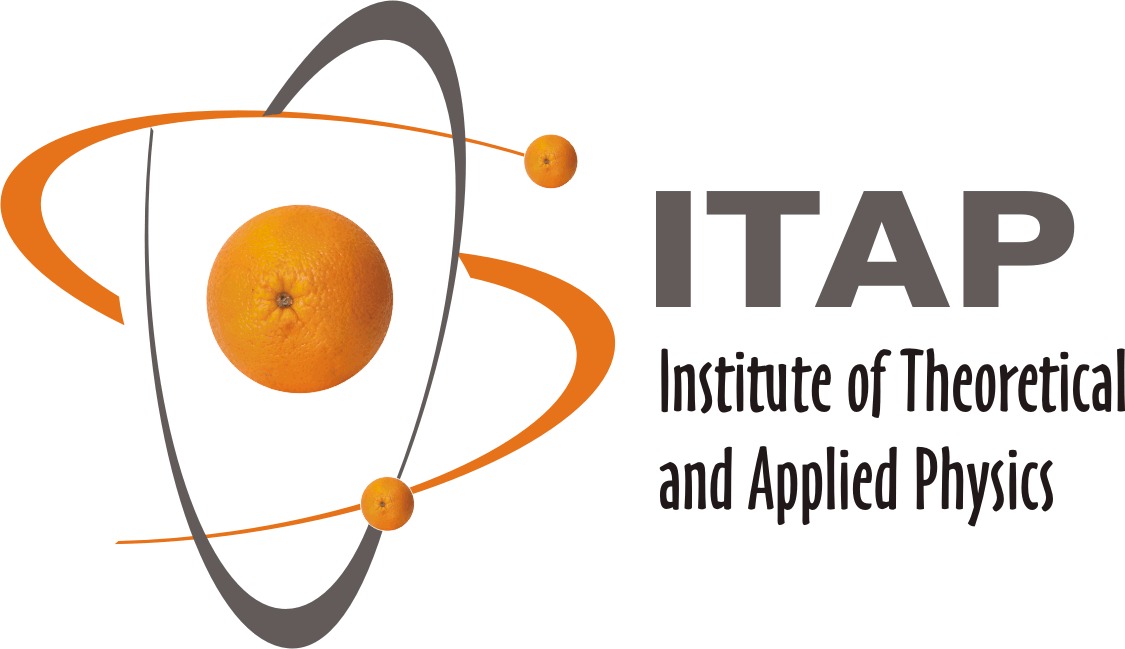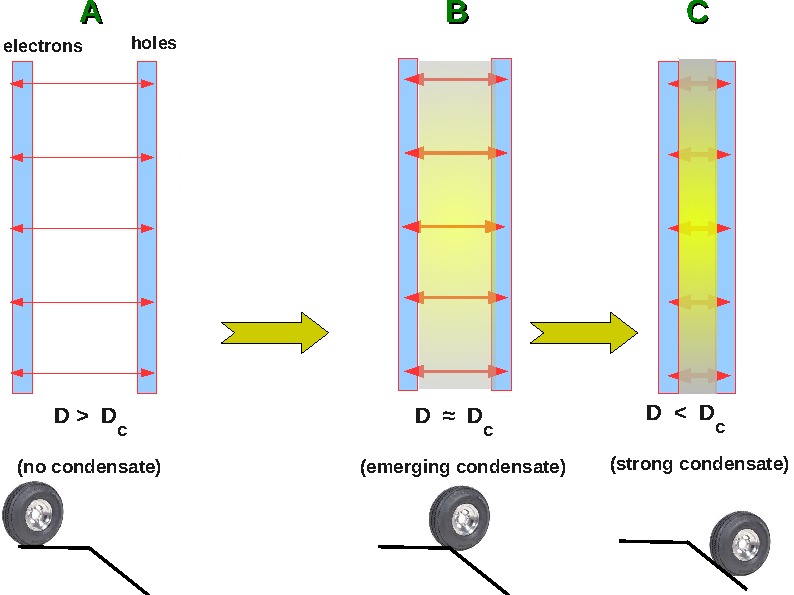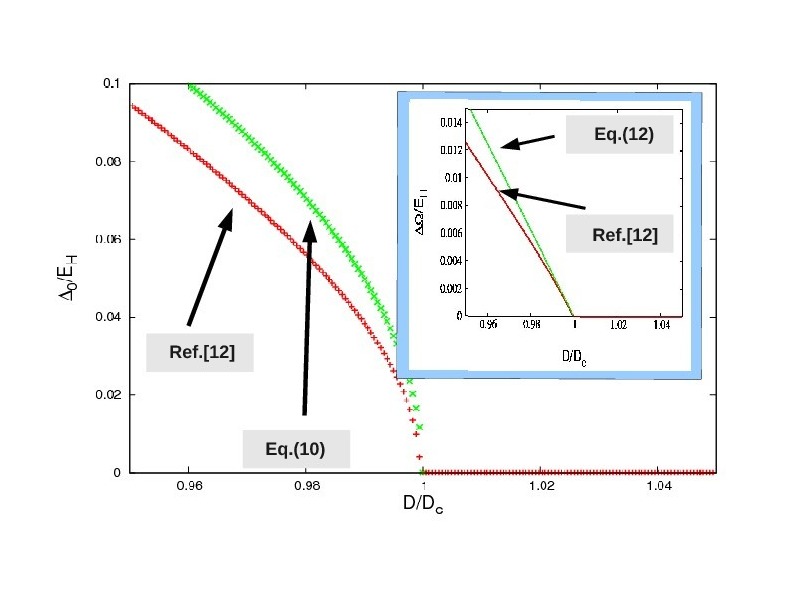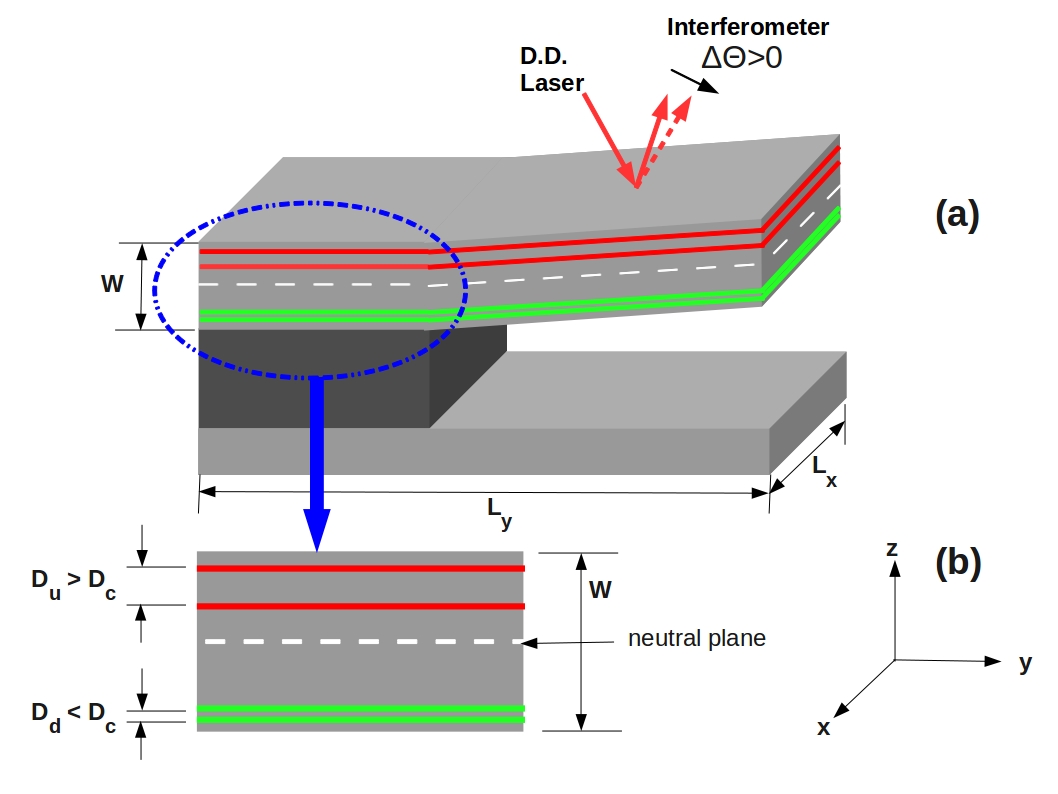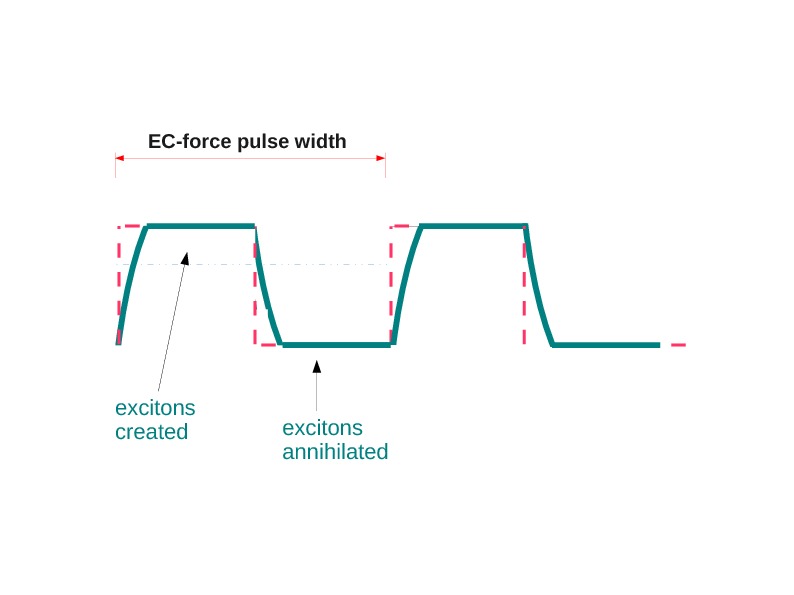Introduction:
Bose-Einstein
condensation of
Wannier-Mott (WM) excitons was predicted by Moskalenko[1], Blatt, Böer
and Brandt[2] in
1962 and elaborated later by the group lead by Keldish [3]. WM excitons
are hydrogen-atom like bound states of interacting
electrons and
holes (Fig.1.a below) itinerant within semiconductor medium and there
has been a
tremendous research to experimentally verify this proposal using bulk
semiconductor samples [4,5]. The driving interaction of the
condensation of the WM excitons is the attractive Coulomb coupling
between electrons and the holes and the repulsive dipolar interaction
between the excitons. However, the short lifetime of the
bulk WM excitons (a few nanosecond)
is insufficient for the thermal equilibrium to be reached before any
condensation can take place. Since early 90's, with the progress made
in growing semiconductor heterojunctions, the search for the
condensation of WM excitons is made by using spatially indirect
electron-hole bands confined in different quantum wells [6] separated
by a
distance comparable to an exciton Bohr radius a0
~ 100 Å as depicted in Fig.1.b below (the double quantum well-DQW
geometry). In addition to this DQW geometry, a strong external electric
field is usually applied [7,8]
to keep the electrons and holes away from each other by pinning their
wavefunctions at
the outer edges of their respective quantum wells.
More specifically, the authors investigate the Coulomb coupling between the interacting and spatially separated electron-hole system confined to two separate quantum wells, and due to the spin neutrality of the Coulomb interaction, the pairs come in all possible spin configurations as shown in Fig.1.c. There are two effects of the attractive Coulomb coupling which is a function of the distance between the electron and the hole wells. If this distance is on the order of an exciton Bohr radius a0 the first effect of the Coulomb coupling is the formation of the electron-hole bound states, i.e. the WM exciton. Below a certain critical temperature (the critical temperature), the second effect of the Coulomb interaction comes into play. In sufficiently low densities (the critical density), when excitons act like independent bosons, they are expected to experience a phenomenon called Bose-Einstein condensation and form a phase coherent ground state, i.e. the exciton condensate (EC). In this new ground state, excitons act collectively very much like the motion of a school of small fish in the sea. This new ground state lowers the free energy of the system with the gap in energy depending on the strength of the Coulomb coupling. Due to the small exciton reduced mass, the critical temperature of the EC is on the order of a few Kelvin. As the density increases, the exciton wavefunctions start spatially overlapping, moving the electrons and the holes into a BCS like condensation.
More specifically, the authors investigate the Coulomb coupling between the interacting and spatially separated electron-hole system confined to two separate quantum wells, and due to the spin neutrality of the Coulomb interaction, the pairs come in all possible spin configurations as shown in Fig.1.c. There are two effects of the attractive Coulomb coupling which is a function of the distance between the electron and the hole wells. If this distance is on the order of an exciton Bohr radius a0 the first effect of the Coulomb coupling is the formation of the electron-hole bound states, i.e. the WM exciton. Below a certain critical temperature (the critical temperature), the second effect of the Coulomb interaction comes into play. In sufficiently low densities (the critical density), when excitons act like independent bosons, they are expected to experience a phenomenon called Bose-Einstein condensation and form a phase coherent ground state, i.e. the exciton condensate (EC). In this new ground state, excitons act collectively very much like the motion of a school of small fish in the sea. This new ground state lowers the free energy of the system with the gap in energy depending on the strength of the Coulomb coupling. Due to the small exciton reduced mass, the critical temperature of the EC is on the order of a few Kelvin. As the density increases, the exciton wavefunctions start spatially overlapping, moving the electrons and the holes into a BCS like condensation.
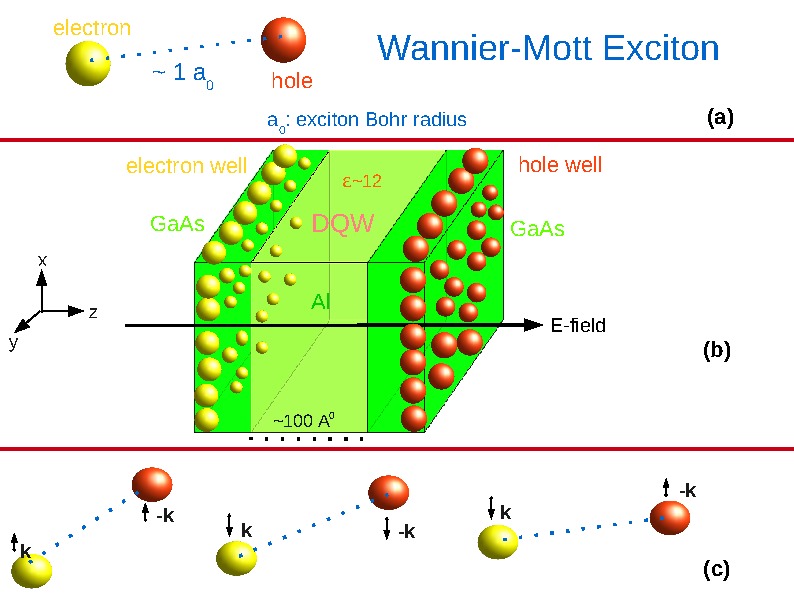
Fig.1. (a)
A description of a Wannier-Mott exciton without the spin degree of freedom indicated. (b) Electron and hole quantum
wells in
a semiconductor DQW. Due to the external electric field the electron
and the hole wavefunctions locate at the outer surfaces of the
respective quantum wells, (c)
Dark and bright excitons.
Symmetries and
other complications:
In
an exciton condensate two different types of pairings are allowed
between an electron in an s-like, and a hole in a p-like orbital
states. The bright pairs are composed of opposite electron and hole
spins combined into a bright singlet and a bright triplet, whereas the
dark triplet pairs are composed of paralel electron and hole spins. In
addition to these complications, the bright and the dark states are not
totally independent. Coupling between the spin and the orbital degrees
of freedom can also be crucially important in many of the semiconductor
heterostructures. There are also fundamental symmetries such as the
time reversal symmetry, spin degeneracy, orbital rotation symmetry,
fermion exchange symmetry, and these play crucial role in the
formation of the EC [9].
The presence or absence of these symmetries affect the interplay
between the dark and the bright components and can even change the
topology of the condensate in the energy-spin space. A
thorough understanding of the exciton condensate (EC) has been
challenging mostly due to these and other inherently experimental
diffculties [10] such
as the short exciton lifetime and the momentum as well as angular
momentum dependence of the residual interactions between the fermionic
constituents. The bright states can couple to the radiation field
through the recombination and pair creation processes due to their odd
total angular momenta, whereas the dark states do not couple. However,
in reality, the dark and the bright states are mixed [11,12]. Two
dark states can also turn into to bright ones through a mechanism
called
Pauli exchange scattering before coupling to the radiation field [13].
Therefore there is always a weak bright component in the ground state
by which the photoluminescence experiments can be made.
Radiative corrections: Electron and hole pairs can recombine to radiate a photon, and this photon with the right energy can also create a pair, but these processes can only happen for the bright states as shown in Fig.2.b and 2.c. These radiative processes cost a positive energy which is not liked much by the other members of the condensate, i.e. the dark excitons. Therefore the bright exciton population in the ground state is dramatically suppresed in favour of the dark states [12]. Pauli scattering of two bright pairs can turn into to dark pairs whereas the reverse process is energetically disfavoured in low temperatures.
Radiative corrections: Electron and hole pairs can recombine to radiate a photon, and this photon with the right energy can also create a pair, but these processes can only happen for the bright states as shown in Fig.2.b and 2.c. These radiative processes cost a positive energy which is not liked much by the other members of the condensate, i.e. the dark excitons. Therefore the bright exciton population in the ground state is dramatically suppresed in favour of the dark states [12]. Pauli scattering of two bright pairs can turn into to dark pairs whereas the reverse process is energetically disfavoured in low temperatures.
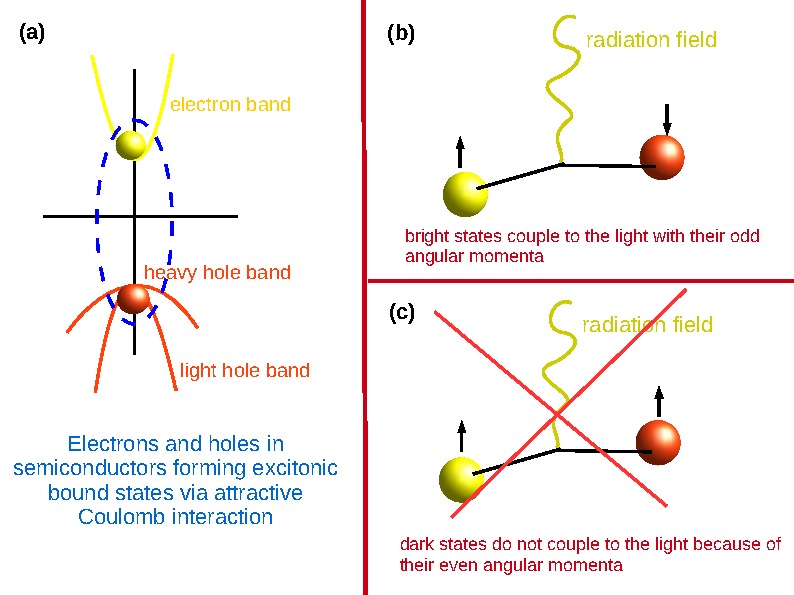
Fig.2. (a) Electron and hole bands in semiconductors
forming excitons. (b) & (c) Radiation field and its
coupling to the bright and dark states.
Until
the recent experiment by High, Leonard,
Hammack, Fogler,
Butov, Kavokin, Campman and Gossard in 2012
(Ref.[14]),
the photoluminescence measurements have been limited in probing all
components of the condensate due to the weakness of the bright
contribution. As
the names suggest, bright
condensates couple to the radiation field(or simply light) where as
their dark counterparts do not. Since photoluminescence experiments can
only probe the bright condensate, the amount of bright states in the
ground state of the coherent exciton gas is essential in these
experiments. Since bright contribution is strongly suppresed by
the dark one, this also makes the photoluminescence experiments highly
difficult. In Ref. [14] using
a Mach-Zhender interference measurements, a clear evidence on
the EC was established by the observation of the
interference fringes. This is a clear evidence that there is a
macroscopic and coherent
order in the ground state, hence the condensate.
It should be realized that EC research with such theoretical and experimental challenges is an outstanding resource in better understanding the unconventional aspects of many body interacting quantum systems in general. The exciton condensate is one of the most difficult examples in condensed matter physics where a variety of different mechanisms and unconventional examples of pairings play leading role all at the same time. It is a common sense to say that, in such a broad area, new effects unknown in other systems should also be expected. In this work, the authors demonstrated that the Coulomb interaction between electrons and holes in the presence of the exciton condensate gives rise to a conceptually new and nonlocal force, which they coined as the EC-force, of which observation is expected not only to shed light on the theoretical and experimental understanding of the EC but also stimulate a broader research on other many body systems where similar effects can arise.
It should be realized that EC research with such theoretical and experimental challenges is an outstanding resource in better understanding the unconventional aspects of many body interacting quantum systems in general. The exciton condensate is one of the most difficult examples in condensed matter physics where a variety of different mechanisms and unconventional examples of pairings play leading role all at the same time. It is a common sense to say that, in such a broad area, new effects unknown in other systems should also be expected. In this work, the authors demonstrated that the Coulomb interaction between electrons and holes in the presence of the exciton condensate gives rise to a conceptually new and nonlocal force, which they coined as the EC-force, of which observation is expected not only to shed light on the theoretical and experimental understanding of the EC but also stimulate a broader research on other many body systems where similar effects can arise.

